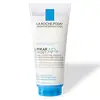What's inside
What's inside
 Key Ingredients
Key Ingredients

 Benefits
Benefits

 Concerns
Concerns

 Ingredients Side-by-side
Ingredients Side-by-side

Water
Skin ConditioningSodium Cocoamphoacetate
CleansingSodium Laureth Sulfate
CleansingMethylpropanediol
SolventDisodium EDTA
Lactic Acid
BufferingZinc Sulfate
AntimicrobialSodium Chloride
MaskingCopper Sulfate
Skin ConditioningPotassium Sorbate
PreservativeXylitol
HumectantFructooligosaccharides
HumectantMannitol
HumectantRhamnose
HumectantPropylene Glycol
HumectantSodium Hydroxide
BufferingGinkgo Biloba Leaf Extract
Skin ConditioningParfum
MaskingWater
Skin ConditioningGlycerin
HumectantSodium Laureth Sulfate
CleansingPEG-200
HumectantPEG-200 Hydrogenated Glyceryl Palmate
CleansingCoco-Betaine
CleansingPolysorbate 20
EmulsifyingCitric Acid
BufferingPEG-7
HumectantGlyceryl Cocoate
EmollientNiacinamide
SmoothingAcrylates Copolymer
Butyrospermum Parkii Butter
Skin ConditioningCocamide Mea
EmulsifyingDisodium EDTA
Glycol Distearate
EmollientMannose
HumectantPolyquaternium-11
Sodium Benzoate
MaskingSodium Chloride
MaskingSodium Hydroxide
BufferingVitreoscilla Ferment
Skin ConditioningWater, Glycerin, Sodium Laureth Sulfate, PEG-200, PEG-200 Hydrogenated Glyceryl Palmate, Coco-Betaine, Polysorbate 20, Citric Acid, PEG-7, Glyceryl Cocoate, Niacinamide, Acrylates Copolymer, Butyrospermum Parkii Butter, Cocamide Mea, Disodium EDTA, Glycol Distearate, Mannose, Polyquaternium-11, Sodium Benzoate, Sodium Chloride, Sodium Hydroxide, Vitreoscilla Ferment
 Reviews
Reviews

Ingredients Explained
These ingredients are found in both products.
Ingredients higher up in an ingredient list are typically present in a larger amount.
Disodium EDTA plays a role in making products more stable by aiding other preservatives.
It is a chelating agent, meaning it neutralizes metal ions that may be found in a product.
Disodium EDTA is a salt of edetic acid and is found to be safe in cosmetic ingredients.
Learn more about Disodium EDTAChances are, you eat sodium chloride every day. Sodium Chloride is also known as table salt.
This ingredient has many purposes in skincare: thickener, emulsifier, and exfoliator.
You'll most likely find this ingredient in cleansers where it is used to create a gel-like texture. As an emulsifier, it also prevents ingredients from separating.
There is much debate on whether this ingredient is comedogenic. The short answer - comedogenic ratings don't tell the whole story. Learn more about comegodenic ratings here.
The concensus about this ingredient causing acne seems to be divided. Research is needed to understand if this ingredient does cause acne.
Scrubs may use salt as the primary exfoliating ingredient.
Learn more about Sodium ChlorideSodium Hydroxide is also known as lye or caustic soda. It is used to adjust the pH of products; many ingredients require a specific pH to be effective.
In small amounts, sodium hydroxide is considered safe to use. However, large amounts may cause chemical burns due to its high alkaline.
Your skin has a natural pH and acid mantle. This acid mantle helps prevent harmful bacteria from breaking through. The acid mantle also helps keep your skin hydrated.
"Alkaline" refers to a high pH level. A low pH level would be considered acidic.
Learn more about Sodium HydroxideSodium Laureth Sulfate (SLES) is a foaming, cleansing, and emulsifying ingredient. It is created from palm kernel oil or coconut oil. SLES is not the same as sodium lauryl sulfate. It is much milder and less likely to irritate.
SLES helps create foam in personal products. It also prevents ingredients from separating, helping to elongate the shelf life.
Sodium Laureth Sulfate is a type of sulfate. It can be drying. We recommend speaking with a professional about using this ingredient if you have concerns.
Learn more about Sodium Laureth SulfateWater. It's the most common cosmetic ingredient of all. You'll usually see it at the top of ingredient lists, meaning that it makes up the largest part of the product.
So why is it so popular? Water most often acts as a solvent - this means that it helps dissolve other ingredients into the formulation.
You'll also recognize water as that liquid we all need to stay alive. If you see this, drink a glass of water. Stay hydrated!
Learn more about Water